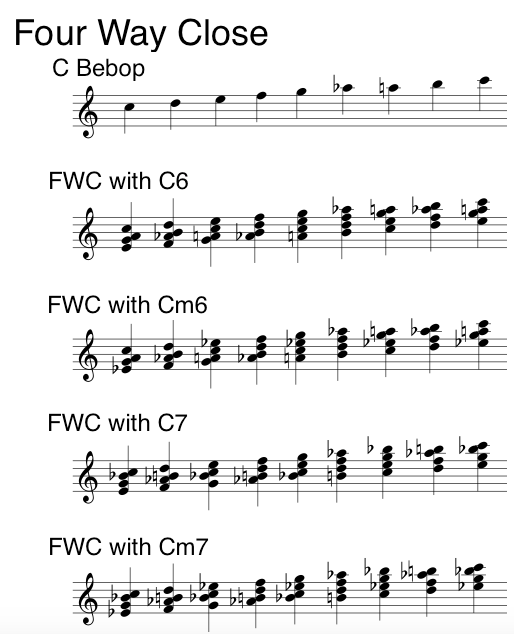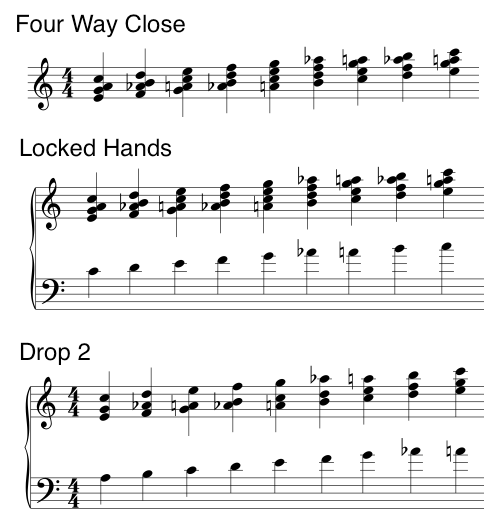Close Position
In a previous lesson we determined that to play in ‘close harmony’ (AKA close position) means to play all the notes of the chord within the range of a single octave. While to play in ‘open harmony’ (AKA open position) means to play all the same notes but over a span larger than an octave. And I stated that playing in open position creates a richer, more balanced and more ‘open’ sound. There is, nevertheless, a place for close position voicings in Jazz – and these are called Four Way Close, Locked Hands and Drop Two Voicings.
Four Way Close Runs
Harmonically, the strongest possible sounding chord progression is a V7-I Perfect Cadence (e.g. G7 to C). And a common Chord Substitution for the V7 chord is a diminished chord one semitone above the root (A♭o7 = Rootless G7♭9).
If you superimpose A♭o7 over a C6 and play all the notes in the form of a scale you get the C Bebop Scale:
- C D E F G A♭A B = C6 + A♭o7 = C Bebop Scale
We can do something interesting with this. If we alternate between the two chords, changing inversions, we can create a little run of chords where the top note moves up in steps. This creates a repeating V7-I sequence which sounds really smooth and really strong. You can do the same with Cm6, C7 and Cm7 chords (though not CMaj7).
- A♭o7 = A♭ B D F
- C6 = C E G A
- Cm6 = C E♭ G A
- C7 = C E G B♭
- Cm7 = C E♭ G B♭

This is called Four Way Close – playing a 4 note chord in close harmony.
This is a great technique to employ when playing a song where the melody moves in steps, such as:
- Blue Bossa
- There will never be another you
- Fly me to the Moon
Locked Hands and Drop 2 Voicings
This technique can be modified in a couple of ways to get two other widely used techniques.
- If you use your Left Hand to double the top melody note an octave lower this gives you a technique called Locked Hands.
- If you omit the second highest note in your Right Hand and play it with your Left Hand an octave lower this gives you a technique called Drop 2. It’s worth mentioning a few of points about Drop 2 Voicings:
- Always drop the second highest note – regardless of what degree it is. This will change with the inversion of the chord
- Root position – second highest note = 5th
- 2nd inversion – second highest note = root
- Drop 2 – literally means you ‘drop the second highest note’. There are also ‘Drop 3’ or ‘Drop 4’ or ‘Drop 2 & 3’ voicings – which follow the same logic, but Drop 2 is the most widely used.
- Always drop the second highest note – regardless of what degree it is. This will change with the inversion of the chord

As an example, take the song Fly me to the Moon
| Original | Melody | FWC Chord | FWC Notes | Lckd Hands | Drop 2 |
|---|---|---|---|---|---|
| Am7 | C | Am7 | EGAC | C-EGAC | A-EGC |
| B | Fo7 (E7) | DFA♭B | B-DFA♭B | A♭-DFB | |
| A | Am7 | CEGA | A-CEGA | G-CEA | |
| G | B♭o7 (A7) | B♭D♭EG | G-B♭D♭EG | E-B♭D♭G | |
| Dm7 | F | Dm7 | ACDF | F-ACDF | D-ACF |
| G | B♭o7 | B♭D♭EG | G-B♭D♭EG | E-B♭D♭G | |
| A | Dm7 | CDFA | A-CDFA | F-CDA | |
| C | Dm7 | DFAC | C-DFAC | A-DFC | |
| G7 | B | G7 | DFGB | B-DFGB | G-DFB |
| A | E♭o7 (D7) | CE♭G♭A | A-CE♭G♭A | G♭-CE♭A | |
| G | G7 | BDFG | G-BDFG | F-BDG | |
| F | A♭o7 (G7) | A♭BDF | F-A♭BDF | D-A♭BF | |
| CMaj7 | E | C6 | GACE | E-GACE | C-GAE |
And note that the Drop 2 voicing can be applied to any song that has a run of chords to make it sound richer and more balanced.
Have a Listen to
- Any and Every George Shearing solo